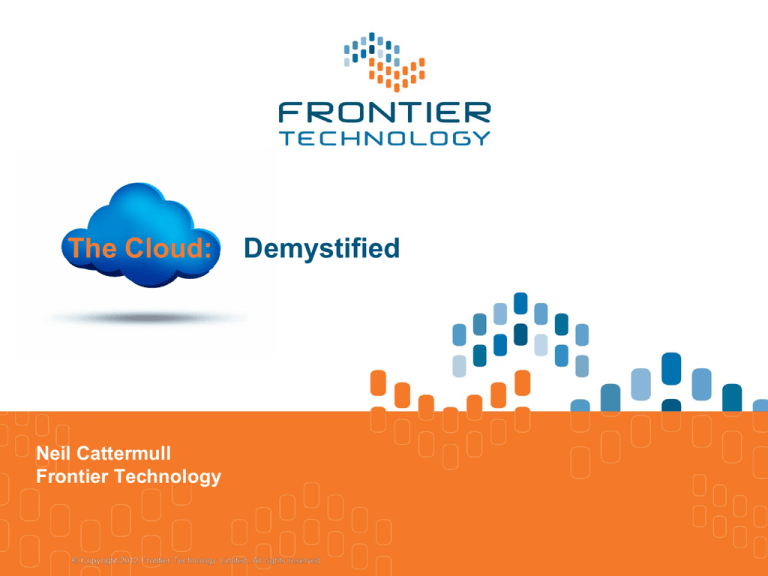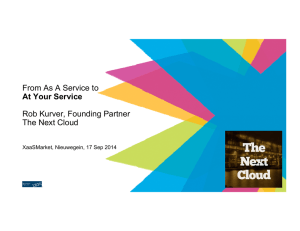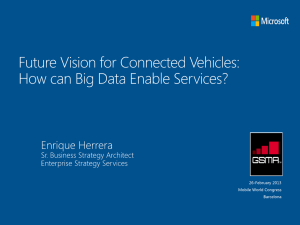
The Cloud:
Neil Cattermull
Frontier Technology
Demystified
Your Journey to the Cloud
© Copyright 2012 Frontier Technology Limited. All rights reserved
The Routes in Your Journey
Hybrid Cloud
Private Cloud
00
Public Cloud
Hosted Private
Cloud
On-Premise/Internal
Off-Premise/Service Provider
The Journey Explained
Public – Services or resources such as
applications and storage offered over the public
internet and available to anyone that wants to
purchase the service. With Public Cloud,
resources are shared between organisations for
cost efficiency.
Google mail, Hotmail or Salesforce.com are held in the 'public cloud'
© Copyright 2012 Frontier Technology Limited. All rights reserved
The Journey Explained
Hybrid Cloud – A hybrid cloud is a composition
of two or more clouds that remain unique entities
but are bound together, offering the benefits of
multiple deployment models. A hybrid cloud is
typically offered in one of two ways: a vendor has
a private cloud and forms a partnership with a
public cloud provider, or a public cloud provider
forms a partnership with a vendor that provides
private cloud platforms.
A hybrid cloud is a cloud computing environment in which an
organisation provides and manages some resources in-house and
has others provided externally.
© Copyright 2012 Frontier Technology Limited. All rights reserved
The Journey Explained
Private Cloud – Private cloud is a cloud
infrastructure dedicated solely to a single
organisation that is managed and hosted
internally behind a firewall on private networks.
What this means is that organisations are able to adapt more
efficiently to web based demands and be more cost effective.
© Copyright 2012 Frontier Technology Limited. All rights reserved
The Journey Explained
Hosted Private Cloud – Hosted Private cloud is
a cloud infrastructure dedicated solely to a single
organisation and is managed and hosted by a
third party behind a firewall on private networks.
What this means is that organisations are able to adapt more
efficiently to web based demands and be more cost effective.
© Copyright 2012 Frontier Technology Limited. All rights reserved
Building Blocks of Cloud
Cloud Clients
Web browser, mobile apps,
thin client, laptop, phones, …
SaaS
CRM, Email, virtual desktop,
communication, games,….
PaaS
Database, web server,
development tools, Execution
runtime…
IaaS
Virtual machines, servers,
storage, load balancers,
network, etc…
© Copyright 2012 Frontier Technology Limited. All rights reserved
The Journey Explained
Cloud SaaS – Software as a Service (SaaS) is a software
distribution model in which applications are hosted by a vendor or
service provider and made available to customers over a network,
typically the Internet.
Software as a Service (SaaS) allows organisations to access
business functionality at a cost typically less than paying for
licensed applications since SaaS pricing is based on a monthly
fee. Also, because the software is hosted remotely, users don't
need to invest in additional hardware. Software as a Service
removes the need for organisations to handle the installation, setup and often daily upkeep and maintenance.
Examples of this infrastructure would be Google Mail & Google Docs.
© Copyright 2012 Frontier Technology Limited. All rights reserved
The Journey Explained
Cloud PaaS – Platform as a Service (PaaS) is a model for
delivering operating systems and associated services over the
Internet without downloads or installation. The service delivery
model allows the customer to rent virtualised servers and
associated services for running existing applications or developing
and testing new ones.
Initial and on-going costs can be reduced by the use of
infrastructure services from a single vendor rather than
maintaining multiple hardware facilities that often perform
duplicate functions or suffer from incompatibility problems.
Examples of this platform would be Microsoft Windows Azure and
Google App Engine.
© Copyright 2012 Frontier Technology Limited. All rights reserved
The Journey Explained
Cloud IaaS – Infrastructure as a Service (IaaS) is a provision
model in which an organisation outsources the equipment used to
support operations, including storage, hardware, servers and
networking components. The consumer does not manage or
control the underlying cloud physical infrastructure but has control
over operating systems, storage, deployed applications, and
possibly limited control of select networking components. The
client typically pays on a per-use basis.
Examples of this platform would be Amazon's Elastic Compute Cloud
(EC2) and Simple Storage System (S3).
© Copyright 2012 Frontier Technology Limited. All rights reserved
A study of 400 major organisations, performed by ZDNET,
confirmed that:
• The cloud is mature -- for some. Half of all respondents said they
were confident that cloud solutions are viable for mission critical
business applications.
• Scalability is driving adoption. Fifty-seven percent of companies
said it was the top reason that they switched to the cloud.
(Business agility was a close second.)
• Security remains the main hurdle. The cloud may be maturing,
but security anxiety is the top reason companies don't make the
switch -- 55 percent of respondents expressed concern about it.
(Rounding out the top three: regulatory compliance and vendor
lock-in.)
A study of 400 major organisations, performed by ZDNET,
confirmed that:
• SaaS leads in dollars spent. A whopping 82 percent of
respondents said they use software-as-a-service offerings today.
An additional six percent said they'd use it within five years.
• But PaaS and IaaS aren't far behind. There's a lot of interest in
platform-as-a-service and infrastructure-as-a-service offerings.
Forty percent of respondents use PaaS today but 72 percent said
they'd adopt it in the next five years; IaaS, 51 percent to 66
percent.
• Efficiency is the name of the game. At 43 percent, backup and
archiving was the number one use case, followed by business
continuity (25 percent), collaboration tools (22 percent) and big
data processing (19 percent).
So, what are the main drivers for a journey
to the Cloud?
15
© Copyright 2009 Frontier Technology Limited. All rights reserved.
Fewer than 20% take up in the EU
for Cloud based services, Why?
What’s Inhibiting Adoption?
© Copyright 2012 Frontier Technology Limited. All rights reserved
The Future of Cloud Technologies?
Community Cloud – Community cloud shares infrastructure
between several organizations from a specific community with common
concerns (security, compliance, jurisdiction, etc.), whether managed
internally or by a third-party and hosted internally or externally.
A healthcare community cloud, for example, could be tailored to provide
specific security and regulatory requirements that are compliant with
HIPAA, the Health Insurance Portability and Accountability Act, which
regulates strict standards for health-related data protection.
Or
A financial services community cloud could be optimised to provide ultralow latency for stock traders to execute financial transactions.
© Copyright 2012 Frontier Technology Limited. All rights reserved
What’s the Future of your Cloud?
© Copyright 2012 Frontier Technology Limited. All rights reserved
Get in Touch:
neil.cattermull@frontiertechnology.co.uk







